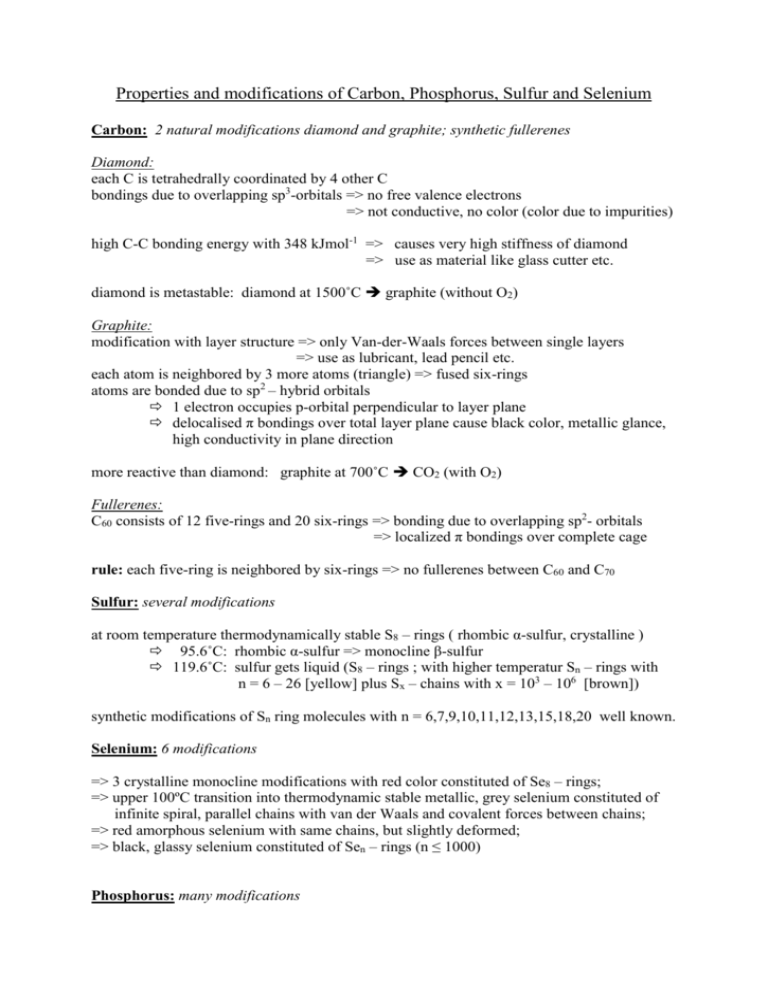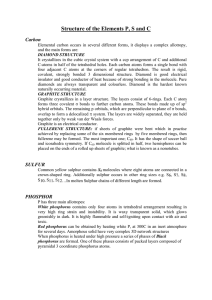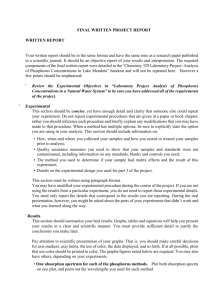Chemical properties and modifications of Carbon, Phosphor, Sulfur
advertisement

Properties and modifications of Carbon, Phosphorus, Sulfur and Selenium Carbon: 2 natural modifications diamond and graphite; synthetic fullerenes Diamond: each C is tetrahedrally coordinated by 4 other C bondings due to overlapping sp3-orbitals => no free valence electrons => not conductive, no color (color due to impurities) high C-C bonding energy with 348 kJmol-1 => causes very high stiffness of diamond => use as material like glass cutter etc. diamond is metastable: diamond at 1500˚C graphite (without O2) Graphite: modification with layer structure => only Van-der-Waals forces between single layers => use as lubricant, lead pencil etc. each atom is neighbored by 3 more atoms (triangle) => fused six-rings atoms are bonded due to sp2 – hybrid orbitals 1 electron occupies p-orbital perpendicular to layer plane delocalised π bondings over total layer plane cause black color, metallic glance, high conductivity in plane direction more reactive than diamond: graphite at 700˚C CO2 (with O2) Fullerenes: C60 consists of 12 five-rings and 20 six-rings => bonding due to overlapping sp2- orbitals => localized π bondings over complete cage rule: each five-ring is neighbored by six-rings => no fullerenes between C60 and C70 Sulfur: several modifications at room temperature thermodynamically stable S8 – rings ( rhombic α-sulfur, crystalline ) 95.6˚C: rhombic α-sulfur => monocline β-sulfur 119.6˚C: sulfur gets liquid (S8 – rings ; with higher temperatur Sn – rings with n = 6 – 26 [yellow] plus Sx – chains with x = 103 – 106 [brown]) synthetic modifications of Sn ring molecules with n = 6,7,9,10,11,12,13,15,18,20 well known. Selenium: 6 modifications => 3 crystalline monocline modifications with red color constituted of Se8 – rings; => upper 100ºC transition into thermodynamic stable metallic, grey selenium constituted of infinite spiral, parallel chains with van der Waals and covalent forces between chains; => red amorphous selenium with same chains, but slightly deformed; => black, glassy selenium constituted of Sen – rings (n ≤ 1000) Phosphorus: many modifications White phosphorus: - can ignite by itself => storage under water; - its build up by tetrahedral P4 – molecules with low valence angle of 60º => molecules are stressed, bulk material is instable and reactive Red phosphorus: - white phosphorus at 180 - 400ºC polymeric, amorphous red phosphorus (without O2) - build up by 3 dimensional network, not toxic, doesn´t ignite by itself (< 300ºC) - each P is linked to three other P Black phosphorus: - thermodynamic stable modification under normal pressure (≤ 550ºC) - bulk material shows metallic glance and behaves like a semiconductor, not poisonous - black phosphor crystallizes in a rhombohedral layer structure (parallel layers of zigzag chains; one of the three bond of P links the layers) Violet phosphorus: - Hittorf´s (German Chemist) phosphorus - monoclinic crystal structure (consisting of parallel oriented pentagonal P-tubes; the tubes of neighboured layers are perpendicular orientated) Tasks: (1) Explain the lubricant effect of graphite. (2) Explain the high reactivity of white phosphor.






